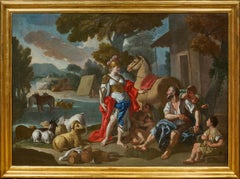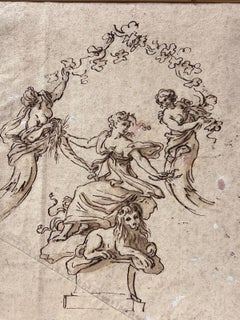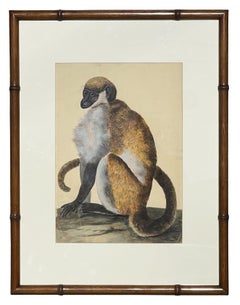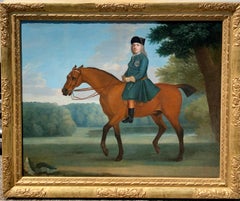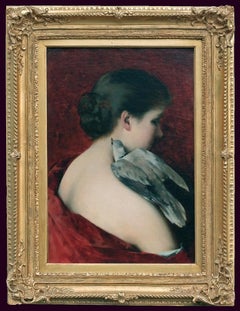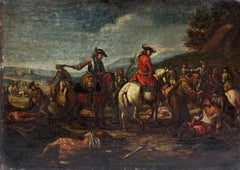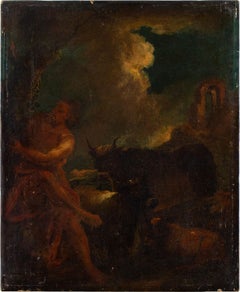Mid-18th Century Animal Paintings
to
4
8
2
9
1
5
5
1
3
4
2
Overall Height
to
Overall Width
to
5
6
3
3
2
2
2
2
2
1
1
1
1
1
1
1
1
128
806
1,638
5,812
52
32
46
55
62
87
129
109
140
169
84
1
1
10
8
4
4
2
Period: Mid-18th Century
Herminia and the Shepherds, a painting by Francesco de Mura (Napoli 1696 - 1782)
Located in PARIS, FR
In this masterly painting, Francesco de Mura presents the meeting of Herminia and the shepherds, a famous episode taken from the seventh canto of Torquato Tasso's Jerusalem Delivered...
Category
Old Masters Mid-18th Century Animal Paintings
Materials
Canvas, Oil
Francesco Zuccarelli Venetian master - 18th century landscape painting - Knights
Located in Varmo, IT
Francesco Zuccarelli (Pitigliano 1702 - Florence 1788) - River landscape with knights and medieval village.
53 x 70 cm without frame, 64.5 x 80.5 cm with frame.
Antique oil paintin...
Category
Rococo Mid-18th Century Animal Paintings
Materials
Canvas, Oil
1700's Venetian Old Master Ink Drawing St. Marks Lion Angelic Figures Flowers
Located in Cirencester, Gloucestershire
The Lion of St. Mark
Venetian Old Master, mid 18th century
circle of Giovanni Battista Tiepolo (Venetian, 1696-1770)
ink and watercolour drawing on paper mounted on a card frame, unf...
Category
Rococo Mid-18th Century Animal Paintings
Materials
Ink, Watercolor
The Infant St John the Baptist with Lamb - Italian Old Master art oil painting
Located in London, GB
This beautiful 18th century Italian Old Master oil painting is something rather special. Painted circa 1750 the subject matter is Saint John the Baptist as a very young child. He is ...
Category
Old Masters Mid-18th Century Animal Paintings
Materials
Oil
Early Naturalistic Wildlife Animal Rendering of a Possible Capuchin Monkey
Located in Houston, TX
Early naturalistic wildlife rendering by the English artist Peter Paillou. The work features a delicately rendered depiction of a possible capuchin monkey from an 18th century specim...
Category
Naturalistic Mid-18th Century Animal Paintings
Materials
Gouache
18th century English portrait of the Duke of Newcastle upon his horse in
By Thomas Spencer
Located in Woodbury, CT
Thomas Spencer was a leading sporting and equestrian artist of the period of John Wootton and James Seymour; his art shows a considerable to debt to tha...
Category
Old Masters Mid-18th Century Animal Paintings
Materials
Canvas, Oil
A Dog with Dead Game
By Jan Weenix
Located in St. Albans, GB
Jan Weenix
Canvas Size: 32 x 26" (82 x 66cm)
Outside Frame Size: 40 x 34" (102 x 86cm)
This beautiful painting is unsigned but this is not unusual with Jan ...
Category
Italian School Mid-18th Century Animal Paintings
Materials
Oil
Portrait of Julien Prieur as a hunter - Circle of Jean-Baptiste Oudry 1686-1755
By Jean-Baptiste Oudry
Located in PARIS, FR
This portrait depicts us the trusted confidant of the Conflans d'Armentières family. More precisely, Julien Prieur was the fiscal procurator of the Marquisate of Armentières, playing the role of representative of the "public ministry", safeguarding the interests of his lord. His role, one can imagine, was crucial at the death of Michel de Conflans (in 1717) since the latter left an heir, Louis, aged only 6, and a widow, Diane Gabrielle de Jussac, whom some memoirs describe as "a very clever grande dame" . Prieur ensured the smooth running of the family's affairs and it is probably to thank him for his services that Diane Gabrielle had his portrait painted, most probably by a painter close to Jean-Baptiste Oudry.
Julien Prieur appears as he is, middle-aged, with a benevolent look, in his hunting suit. Only his knotted wig links him to the nobility.
Above all, he is depicted as a hunter, a passion that he shared with the Marquis of Armentières. His very young master, Louis, became a first-rate hunter, hunting in the King's entourage, in whose cabinet he died of apoplexy in January 1774. As for the his son, he was one of Louis XVI's closest hunting companions, as numerous souvenirs attest .
1. Some biographical information about the model and the commissioner
While the identity of many 18th century portraits is uncertain, an old label stuck on the reverse of the canvas gives us some precise information on the identity of the model: "Mr. Julien Prieur, homme d’affaires de Mr. le Marquis d'Armentières - Commune of Brécy - Aisne". The label also suggests that it could be his son Louis Prieur living in Rocourt (probably Rocourt-Saint-Martin, a neighbouring municipality of Brécy), born on 30 September 1745, who died on 8 July 1826, but this hypothesis must be rejected in view of the model's clothing. This label probably gives us an indication on the previous owner the owner of this painting; we will see later why it seems likely that this label was affixed between 1826 and 1832.
Brécy is now a municipality in the Aisne County (Hauts-de-France) located between Soissons and Château-Thierry, slightly north of the Paris-Reims axis. It borders the municipalities of Armentières-sur-Ourcq and Rocourt-Saint-Martin. According to Louis Prieur's death certificate, he was in fact born in 1743 and not in 1745 . The age of the model in the painting and the dating of this painting would indicate that Julien Prieur, was probably born at the very end of the 17th century.
In Louise-Marthe de Conflans-Coigny, chatelaine de Brécy , we read that "the Conflans were a family of ancient nobility, which genealogists trace back to the 12th century, when it was said to have come from the house of Brienne. In the 16th and 17th centuries, this family had several illustrations in the profession of arms. [...] Michel de Conflans, [...] belonged to a younger branch of the family, of which Saint-Simon wrote, with his acid soaked pen, that "poor and obscure, they had never left their village, where their house resembled a hut" and elsewhere that they "lived on their rifles and cabbages".
Fortunately for Michel de Conflans, the last representative of the elder branch, Henriette d'Armentières, made him her heir on her death in 1712. It was through her that the land of Armentières and its 14th century castle became part of the estate of this branch, as well as, not far from there, the land of Brécy and the castle of Le Buisson, where the family lived. In the early years of the 18th century, Michel de Conflans was able to push himself into the entourage of the Duke of Orleans, becoming his first gentleman of the chamber. However it was above all his son Louis who restored the family status through his military career.
Born on 23 February 1711, Louis de Conflans, Marquis d'Armentières died of apoplexy on 18 January 1774, in the King's cabinet at Versailles. Appointed lieutenant general in 1746, he received his Marshal of France’s stick in 1768. The Dictionary of French Biography writes of him that "without ever achieving a high command, he appeared with honour in all the wars of his time".
The estates of Armentières and Le Buisson were sequestered during the French Revolution, declared national property and sold at auction (in 1794 and 1795 respectively) after the Marquise d'Armentières, the Marshal's second wife, was beheaded in 1794.
The Château du Buisson (where Michel de Conflans died in 1717) was bought by a granddaughter of the Marshal de Conflans, the Marquise de Coigny, in 1816 and remained in her family after her death in 1832 until the sale of the 1,054 hectares estate in 1866.
The bayonet blows that probably pierced the canvas in three places may well have a revolutionary origin and it is conceivable that the painting, acquired by the Marquise de Coigny from Louis Prieur, Julien's son, after the latter's death, was then restored and given the label specifying the name of the model.
2. Description of the portrait
The painting presents a man in his thirties in his hunting costume. Pictured at mid-body, his face is marked by his life in the open air and characterised by a look of great bonhomie. Holding a rifle under his elbow, he is soberly dressed in a large caramel-coloured jacket, decorated with silver buttons. Presented in a three-quarter view, the model holds a partridge in his right hand. The jacket opens onto a vermilion waistcoat. A green shoulder strap probably holds a powder flask hidden under his arm while a satchel is visible on his belt.
The model is wearing a grey wig, tied at the back with a black ribbon that seems to fly in the wind. This ornament anchors Julien Prieur in his time. "The new King of France, Louis XV, [imposed] a style of smaller wigs for men and the rigorous white or preferably greyish powdering. From the middle of the century men also used a ponytail on the back of the neck, tied with a ribbon, a style that became very popular in all courts."
He stands out against a dark, purplish sky at the end of an autumn day in a soberly sketched forest landscape. The treatment of the sky recalls the influence of Largillière, Oudry's first master.
3. Jean-Baptiste Oudry
Jean-Baptiste Oudry was born on 17 March 1686 in Paris, rue de la Ferronnerie. He began his apprenticeship around 1705-1707 with Nicolas de Largillière, with whom he stayed for five years.
In 1713 Oudry established his "livre de raison" in which he reproduced all his early works in wash drawings up until 1718. During this first period which lasted about 7 years, Oudry produced works of great diversity, both in the genres that the artist tackled and in the artists which influenced him. It has been estimated that he painted about 150 pictures during this period: mainly portraits, but also still lifes and some religious paintings and landscapes.
Of the hundred or so portraits that Oudry is said to have painted during this period, only fifteen have been identified today. A number of those lost portraits are probably still confused with works by Largillière.
First admitted to the Académie de Saint-Luc in 1708, he was then allowed to join the Académie Royale in 1717, and subsequently admitted as a history painter in 1719. This year marks a turning point from which Oudry will assert himself as an animal painter. In 1723 he met Louis Fagon, Intendant of Finances, and the Marquis de Beringhen, the King's first equerry, who became both friends and patrons of the artist, giving him access to royal commissions and enabling him to be appointed as painter of the Royal Tapestry Factory of Beauvais in 1726.
From 1728 onwards, the creation of tapestries became the core of his work, even though at the same time Oudry developed his skill as an illustrator, first for Scarron's Roman Comique and then for La Fontaine’s Fables.
Between 1726 and 1731, Oudry created the decoration of a large drawing room at the château de Condé-en-Brie, about twenty kilometres from Brécy, which has remained in place to this day. This important commission, about which few details are known, is said to have originated with the Countess de Verrüe, a great lady of the French Regency who often stayed at Condé with her friend Jean-François Leriget, Marquis de la Faye, then owner of Condé.
A prolific artist, Oudry fulfilled numerous commissions in parallel with his regular contributions to the Salons, to which he regularly took part until 1753. He suffered a stroke in 1754 and died the following year.
It seems almost certain, in view of the importance of his work, that Oudry supervised a workshop in which several artists were involved, but this point is very poorly documented. Given the geographical proximity of Brécy and Condé-en-Brie, the links between the Armentières family and the Condé patrons, and finally based upon the quality of our portrait, we propose the hypothesis that it was painted by one of the painters who worked with Oudry at Condé.
4. Related artworks: comparison with some other portraits of hunters by Jean-Baptiste Oudry
While Oudry gradually abandoned portraiture from 1720 onwards to devote himself to animal paintings, he seems to have made an exception for hunter portraits, which were often depicted in the company of their hunting dogs. Two examples seem particularly evocative and suggest a dating for our painting around 1730. We will see in a second part why this dating proposal seems relevant.
The first portrait worth mentioning is the presumed portrait of Lieutenant Claude-André Courtin de Crouey, lord of Quatre Fils and Cormeilles-en-Parisis made in 1723, reproduced below. Also presented in a very tight frame, it is interesting for the similarities in the representation of the rifle, and in particular the two metal rivets that are almost identical in our painting.
The painting that seems closest to ours is the presumed portrait of Monsieur...
Category
Old Masters Mid-18th Century Animal Paintings
Materials
Canvas, Oil
18th century portrait of a Spaniel dog with fruit in a wooded landscape.
By Tobias Stranover
Located in Woodbury, CT
Outstanding early 18th-century portrait of a seated Spaniel dog in a landscape with an array of fruits.
Attributed to the work of Tobias Stranover.
...
Category
Old Masters Mid-18th Century Animal Paintings
Materials
Oil
Decorative Panels of an Ancient Drugstore - Oils on Canvas by A. Peyrotte
Located in Roma, IT
The panels were designed ad decorations for 18th century french drugstores, and can be compared to those designed by the same Peyrotte (who was painter and furnitures designer for th...
Category
Mid-18th Century Animal Paintings
Materials
Oil
Related Items
Portrait of a Young Girl with a Dove
Located in Saint-Ouen, FR
Lacazette Amelie (19th)
Young Girl with a dove
Oil on canvas signed upper left
Old frame gilded with leaves
Dim canvas : 56 X 37 cm
Dim Frame : 74 X 57 cm
Lacazette Amelie (19th) -
...
Category
Academic Mid-18th Century Animal Paintings
Materials
Oil
Military Encampment Soldiers on Horseback Dusk Landscape 1700's Oil Painting
Located in Cirencester, Gloucestershire
The Military Encampment
Circle of Carel van Falens (1683-1733, Flemish)
oil on canvas, unframed
canvas: 8 x 10.5 inches
provenance: private collection, UK
condition: very good and so...
Category
Old Masters Mid-18th Century Animal Paintings
Materials
Canvas, Oil
Berger et ses moutons au soleil couchant
Located in Columbia, MO
Ferdinand du Puigaudeau (1864–1930) was a French painter known for his Impressionist and Post-Impressionist landscapes, particularly those depicting the coastal regions of Brittany. ...
Category
Pointillist Mid-18th Century Animal Paintings
Materials
Canvas, Oil
Portrait of a Girl with a Puppy - Scottish Edwardian art portrait oil painting
Located in London, GB
This stunning Edwardian portrait oil painting is attributed to Scottish Kirkcudbright School artist William Stewart MacGeorge. Painted circa 1910, The painting shows the influences o...
Category
Realist Mid-18th Century Animal Paintings
Materials
Canvas, Oil
Huge 17th Century Italian Old Master painting The Return of the Ark of Covenant
Located in Cirencester, Gloucestershire
Late 17th Century Italian School.
The Return of the Ark on the Covenant,
Oil on Canvas, in a Fine 17th Century Italian Frame,
canvas: 40.25" x 49.75" (102.3 x 126cm)
Fine quality and rare 17th century Italian Old Master...
Category
Old Masters Mid-18th Century Animal Paintings
Materials
Canvas, Oil
19th Century Landscape Oil Painting - Deer by the Banks of a Lake
By Jacob Thompson
Located in London, GB
Jacob THOMPSON (1806 – 1879)
Deer by the Banks of a Lake
1842
oil on canvas
18.9 x 27.6 inches;
22.5 x 31 inches Inc. frame
Jacob Thompson (1806–1879) was an English landscape-pa...
Category
Old Masters Mid-18th Century Animal Paintings
Materials
Oil
19th century English portrait painting of a white poodle dog sitting upright
Located in Bath, Somerset
A white poodle, sitting upright on its hind legs.
Oil on canvas in a giltwood frame, bearing a plaque 'Henry Bernard Chalon 1770-1849'.
Canvas size: 33 x 26cm
In frame: 45 x 37cm
Provenance:
Phillips sale, London, 24 November 1998, lot 140.
David Messum, London
One of the more important painters of his time, Chalon was the son of Jan Chalon, a Dutch musician and engraver from Amsterdam (1749-95), and 'Jackey' Barnard, the daughter of Sir John Barnard, a financier, London merchant, Lord Mayor and M.P. (1722-61). Chalon studied at the Royal Academy schools and married a sister of the artist James Ward. Their daughter Maria A. Chalon became a miniaturist. Chalon became estranged from his wife and James Ward tried, unsuccessfuly, to damage his career.
Chalon had considerable success as a painter and in 1795 was appointed animal painter to the Duchess of York...
Category
English School Mid-18th Century Animal Paintings
Materials
Oil, Canvas
Yellowstone River at Big Timber
Located in Denver, CO
Waddell's paintings are a combination of rough marks, thick paint, transparent elegant strokes, and, on a few occasions a slow, hard line scratched into the canvas. You can feel the ...
Category
Contemporary Mid-18th Century Animal Paintings
Materials
Canvas, Encaustic, Oil
Blue Dream
Located in Bogotá, Bogotá
Immerse yourself in a unique visual experience with this oil painting in shades of blue and violet. The artwork features enigmatic figures of men and animals coming to life in a noct...
Category
Surrealist Mid-18th Century Animal Paintings
Materials
Pastel, Oil, Cotton Canvas
Fox Hunt
Located in Hillsborough, NC
Oil painting of horses and hounds set on a country road, this is a contemporary 20th century landscape painting in excellent condition. The color is c...
Category
Realist Mid-18th Century Animal Paintings
Materials
Canvas, Oil
Portrait Kitten - Cat - French School Oil Painting 21th
Located in Zofingen, AG
Portrait Kitten - Cat
Animal portrait. - Cat -
Technique: oil, acrylic, and ink on old book pages on wooden frame 40x40cm ■■ 15,8x15,8 inch
》》R E A D Y -- T O -- H A N G《《
❶ → O...
Category
Pop Art Mid-18th Century Animal Paintings
Materials
Ink, Oil, Acrylic
H 15.75 in W 15.75 in D 1.38 in
18th Oil Painting Horses Feeding at the Stables
Located in London, GB
James Seymour (1702–1752)
Feeding Time in the Stables
Oil on canvas
32 x 38 inches inc. frame
Provenance: Private Collection, Lambourn
James Seymour (1702–1752) was an English painter, widely recognized for his equestrian art.
Seymour was born in London. His father was an amateur artist and art dealer, whose other business dealings (as a banker, goldsmith, and diamond merchant) afforded young Seymour the leisure time to study art on his own, either his father's or the art at the Virtuosi Club of St. Luke - a gentleman's club his father belonged to, specializing in art. In a short time the boy was a self-taught artist, familiar with many of the prominent artists of the period.
Seymour's love of art was matched only by his love of horses. He began spending time at racetracks early on, and before long found himself absorbed in the sport - drawing, painting, owning, breeding, and racing horses. His art proved popular among the prominent sporting families of the day, eventually garnering Seymour patrons in Sir William Jolliffe and Charles Seymour, 6th Duke of Somerset...
Category
Old Masters Mid-18th Century Animal Paintings
Materials
Oil
Previously Available Items
18th-Century Swedish School, Hercules Slaying The Dragon Ladon, Oil Painting
Located in Cheltenham, GB
This mid-18th-century Swedish oil painting depicts the ancient Greek hero, Hercules, slaying the serpentine dragon Ladon in the Garden of the Hesperides.
It’s a remarkable piece and...
Category
Folk Art Mid-18th Century Animal Paintings
Materials
Oil, Canvas
Large 18th Century Italian Oil Romantic Classical Landscape Figures Animals
Located in Cirencester, Gloucestershire
Figures & Animals in Classical Landscape
Italian, mid 18th century
oil on canvas, framed within a 6 inch deep antique gilt frame
framed: 27.5 x 33.5 inches x 6 inches deep
canvas: 19...
Category
Romantic Mid-18th Century Animal Paintings
Materials
Canvas, Oil
H 27.5 in W 33.5 in D 6 in
18th-Century Cusco School, Santiago Matamoros, Oil Painting
Located in Cheltenham, GB
This 18th-century Peruvian oil painting depicts James Matamoros, the former Patron Saint of Spain, holding a sword and cross while riding a white...
Category
Folk Art Mid-18th Century Animal Paintings
Materials
Canvas, Oil
Fine 18th Century French Watercolor Peacocks in Classical Ruins Landscape
Located in Cirencester, Gloucestershire
Artist/ School: Circle of Jean-Baptiste Oudry (1686-1755) French
Title: Peacocks in a Palatial Garden amidst classical ancient ruins.
Medium: waterc...
Category
Old Masters Mid-18th Century Animal Paintings
Materials
Watercolor
Fine 18th Century Italian Still Life of Flowers in Chinese Vase Ornamental Bird
Located in Cirencester, Gloucestershire
"Flowers in a Chinese Vase"
Italian School, 18th century
oil painting on canvas, framed
canvas: 22.25” x 27” (56.5 x 68.5cm)
provenance: private collection, France
Fine quality large scale antique Italian oil painting, typical of the Rococo period, depicting this still life of flowers within a Chinese vase; an ornamental bird...
Category
Rococo Mid-18th Century Animal Paintings
Materials
Canvas, Oil
Magnificent C18th Painting - African Martial Eagle Stood on a Red Leg Partridge
By (After) George Stubbs
Located in London, GB
Circle of George Stubbs (1741-1806)
African Martial Eagle Stood on a Redleg Partridge
oil on oak panel
36 x 30.25 inches, inc. frame
circa 1750
This fascinating and strong mid-18th ...
Category
Old Masters Mid-18th Century Animal Paintings
Materials
Oil
18th Century Oil Painting of Race Horse Jockey up on Newmarket Heath
By Thomas Spencer
Located in London, GB
Attributed to Thomas SPENCER (1700-1765, English)
Racehorse Jockey Up at Newmarket and with other riders and Newmarket Heath beyond
c. 1740
Oil on canva...
Category
Mid-18th Century Animal Paintings
Materials
Oil
18th Century Old Master Continental School Landscape with Figures
Located in Buffalo, NY
18th century old master school painting. Oil on canvas, circa 1750. Unsigned. Displayed in a giltwood frame. Image size, 18"L x 20"H, over...
Category
Old Masters Mid-18th Century Animal Paintings
Materials
Canvas, Oil
18th Century Old Master Continental School Landscape with Figures on Horseback
Located in Buffalo, NY
18th century old master school painting. Oil on canvas, circa 1750. Unsigned. Displayed in a giltwood frame. Image size, 26"L x 18"H, over...
Category
Old Masters Mid-18th Century Animal Paintings
Materials
Canvas, Oil
H 23 in W 31 in D 2 in
A Grey Stallion Being Held by His Groom in a Classical Landscape
Located in London, GB
Attributed to John WOOTTON (c. 1682-1764, English)
A Grey Stallion Being Held by His Groom in a Classical Landscape
oil on canvas
51.5 x 60 inches, inc...
Category
Old Masters Mid-18th Century Animal Paintings
Materials
Oil
A View of Cock Green, Surrey
By Dominic Serres
Located in London, GB
A View of Cock Green, Surrey
Signed D. Serres and dated 1760 lower left
Oil on canvas
26 x 33 inches
35.5 x 41.5 inches
In an exquisite 18th Century carved and gilded frame
Illustration and details in Colonel M.H. Grant – “The Old English Landscape Painters”
Provenance
- Colonel Grant's collection
- 1964 Luther Gallery collection
Literature
C. R. Grundy, English Art, 1928
M. H. Grant, The Old English Landscape Painters, Vol. II, p 152, Pl. 69.
Connoisseur Magazine, September 1964
Exhibition
- Early English Landscapes, Arts Council 1952/3
- Kenwood House, 1967
Dominic Serres...
Category
Old Masters Mid-18th Century Animal Paintings
Materials
Oil
Study of a goat
By Francesco Londonio
Located in Woodbury, CT
Very well painted oil on card of a standing goat by Francesco Londonio. He was a painter of animal subjects during the middle of the 18th century.
Category
Old Masters Mid-18th Century Animal Paintings
Materials
Oil
Recently Viewed
View AllMore Ways To Browse
Cattle Ranching
Aviary Art
19th Century Art Dog Portraits
Blue Dog Canvas
Western Horse Drawing
Paintings Of Pigs
Mexican Antiques Gold
Acrylic Bunny
Slonem Diamond
Animal Love Summer
Hunting Dog Art
Old Master Dog
Hunt Slonem Diamond
Horse Oil Sporting Art
Paintings Yellow Dog
Black Forest Rabbit
Realism Wildlife Paintings
Gold Framed Bunny Oil Painting
